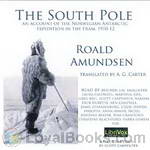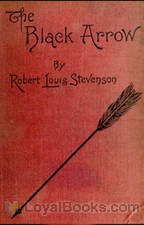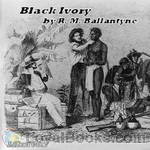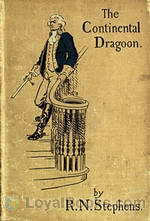|
Books Should Be Free Loyal Books Free Public Domain Audiobooks & eBook Downloads |
|
|
Books Should Be Free Loyal Books Free Public Domain Audiobooks & eBook Downloads |
|
History Books |
|---|
|
Book type:
Sort by:
View by:
|
By: Roald Amundsen (1872-1928) | |
|---|---|
 The South Pole; an account of the Norwegian Antarctic expedition in the Fram, 1910-12
The South Pole; an account of the Norwegian Antarctic expedition in the Fram, 1910-12
In contrast to Scott’s South Pole expedition, Amundsen’s expedition benefited from good equipment, appropriate clothing, and a fundamentally different primary task (Amundsen did no surveying on his route south and is known to have taken only two photographs) Amundsen had a better understanding of dogs and their handling, and he used of skis more effectively. He pioneered an entirely new route to the Pole and they returned. In Amundsen’s own words: “Victory awaits him who has everything in order — luck, people call it... | |
By: Robert Armitage Sterndale | |
|---|---|
 Natural History of the Mammalia of India and Ceylon
Natural History of the Mammalia of India and Ceylon
NATURAL HISTORY OF THE MAMMALIA OF INDIA AND CEYLON.By Robert A. Sterndale, F.R.G.S., F.Z.S., &C., PREFACE. This work is designed to meet an existing want, viz.: a popular manual of Indian Mammalia. At present the only work of the kind is one which treats exclusively of the Peninsula of India, and which consequently omits the more interesting types found in Assam, Burmah, and Ceylon, as well as the countries bordering the British Indian Empire on the North. The geographical limits of the present work have been extended to all territories likely to be reached by the sportsman from India, thus greatly enlarging the field of its usefulness... | |
By: Robert Arnold | |
|---|---|
 The Dismal Swamp and Lake Drummond, Early recollections Vivid portrayal of Amusing Scenes
The Dismal Swamp and Lake Drummond, Early recollections Vivid portrayal of Amusing Scenes
| |
By: Robert B. Booth (1843?-) | |
|---|---|
 Five Years in New Zealand 1859 to 1864
Five Years in New Zealand 1859 to 1864
| |
By: Robert Balmain Mowat (1883-1941) | |
|---|---|
 Wars of the Roses 1377-1471
Wars of the Roses 1377-1471
The Wars of the Roses, 1377-1471, were a series of English civil wars fought for the control of the throne of England between two rival cadet branches of the House of Plantagenet, Lancaster and York. The Scottish historian, Robert Balmain Mowat writes that these wars saw "the death of the old England and the beginning of the new." But they also saw the emergence of great personalities: the noble Richard of York, Warwick the Kingmaker, King Edward IV, indolent and energetic by turns, and his relentless opponent, Margaret of Anjou, a true she-wolf of France. | |
By: Robert Charles Hope (1855-1926) | |
|---|---|
 The Leper in England: with some account of English lazar-houses
The Leper in England: with some account of English lazar-houses
| |
By: Robert Dale Owen (1801-1877) | |
|---|---|
 Wrong of Slavery, the Right of Emancipation, and the Future of the African Race in the United States
Wrong of Slavery, the Right of Emancipation, and the Future of the African Race in the United States
"The Wrong of Slavery" is a work written by Robert Dale Owen based largely off of the work of the Freedmen's Inquiry Commission where he served. It traces the early beginnings of the slave trade from its English beginning to the United States Civil War. It puts a focus on the barbarism of the slave trade from capture and transportation to the arrival in the Americas, the extreme cruelties that took place in the West Indies and South America, facts about slavery in the United States, and the advantages of a freed black population to the South. | |
By: Robert Derby Holmes | |
|---|---|
 A Yankee in the Trenches
A Yankee in the Trenches
| |
By: Robert Edward Lee (1807-1870) | |
|---|---|
 Recollections and Letters of General Robert E. Lee
Recollections and Letters of General Robert E. Lee
| |
By: Robert Elliott Flickinger (1846-) | |
|---|---|
 The Choctaw Freedmen and The Story of Oak Hill Industrial Academy
The Choctaw Freedmen and The Story of Oak Hill Industrial Academy
| |
By: Robert Falcon Scott (1868-1912) | |
|---|---|
 The Journals of Robert Falcon Scott
The Journals of Robert Falcon Scott
Capt. Robert F. Scott's bid to be the leader of the first expedition to reach the South Pole is one of the most famous journeys of all time. What started as a scientific expedition turned out to be an unwilling race against a team lead by R. Admunsen to reach the Pole. The Norwegian flag already stood at the end of the trail when Scott's party reached their target. All the five men of the Scott expedition who took part in the last march to the Pole perished on their way back to safety. Robert F. Scott kept a journal throughout the journey, all the way to the tragic end, documenting all aspects of the expedition... | |
By: Robert Forsyth Scott (1849-1933) | |
|---|---|
 St. John's College, Cambridge
St. John's College, Cambridge
| |
By: Robert Franklin Pennell | |
|---|---|
 Ancient Rome : from the earliest times down to 476 A. D.
Ancient Rome : from the earliest times down to 476 A. D.
| |
By: Robert Futrell (1917-1999) | |
|---|---|
 Vietnam: The Advisory Years to 1965
Vietnam: The Advisory Years to 1965
This book explains the policy of the United States and France toward Vietnam beginning after World War II until the beginning of America's entry into the Vietnam War in 1965. Summary by Craig Campbell | |
By: Robert G. Latham (1812-1888) | |
|---|---|
 A Handbook of the English Language
A Handbook of the English Language
| |
By: Robert Glass Cleland (1885-1957) | |
|---|---|
 History of California: The American Period
History of California: The American Period
The Author's own summary surveys “first the faint awakenings of American interest in the Spanish province of Alta California. The New England merchants traffic again along the sunlit, poorly guarded coast; the shadow of Russia hangs for a moment over San Francisco Bay; the hide and tallow vessels laboriously collect their cargoes at every little port...the first adventurous immigrants wind wearily down the mountain trails.... “Then the scene changes...English ambitions hold a threat of danger to the program of the United States; the Sacramento settlers raise the crude Bear Flag as a symbol of revolt; and finally a strong-willed President acquires California as the fruit of war... | |
By: Robert Henry Reece (1889-) | |
|---|---|
 Night Bombing with the Bedouins
Night Bombing with the Bedouins
| |
By: Robert Heywood (1786-1868) | |
|---|---|
 A Journey in Russia in 1858
A Journey in Russia in 1858
| |
 A Journey to America in 1834
A Journey to America in 1834
| |
By: Robert Hugh Benson (1871-1914) | |
|---|---|
 The King's Achievement
The King's Achievement
| |
By: Robert James Cressman | |
|---|---|
 Infamous Day: Marines At Pearl Harbor 7 December 1941
Infamous Day: Marines At Pearl Harbor 7 December 1941
Historical overview and personal reminiscences published in 1992. Pearl Harbor attack 7 December 1941. Part of U.S. Government U.S. Marine Corps World War II Commemorative Series. - Summary by David Wales | |
By: Robert James Manion (1881-1943) | |
|---|---|
 Surgeon In Arms
Surgeon In Arms
Robert James Manion was a Canadian doctor who volunteered in the Canadian medical corps during World War I. This book is his memoir of the war. After the war he entered politics and served in several Canadian governments. The listener may note a lack of mention of the United States soldier; this is because the memoir was written before the entry of that country into the war. - Summary by David Wales | |
By: Robert John Buckley | |
|---|---|
 Ireland as It Is And as It Would be Under Home Rule
Ireland as It Is And as It Would be Under Home Rule
| |
By: Robert Johnston | |
|---|---|
 Presbyterian Worship Its Spirit, Method and History
Presbyterian Worship Its Spirit, Method and History
| |
By: Robert Joseph Kerner (1887-1956) | |
|---|---|
 The Russian Revolution; the Jugo-Slav Movement
The Russian Revolution; the Jugo-Slav Movement
| |
By: Robert Lansing (1864-1928) | |
|---|---|
 The Peace Negotiations A Personal Narrative
The Peace Negotiations A Personal Narrative
| |
By: Robert Louis Stevenson (1850-1894) | |
|---|---|
 Kidnapped
Kidnapped
Kidnapped is the story of a 16-year old young man who is searching for his true birthright and is determined to make a fortune after the death of his parents. This timeless tale by Robert Louis Stevenson follows the life of David Balfour who leaves his home in Scotland after the death of his parents. First he meets his uncle for the first time in his life. His uncle is a very mean person who, at first, tried to kill David by devious means but then got him kidnapped onto a slave ship. In the ship, David makes friends with a Scottish rebel and together they successfully defeat the ship’s crew... | |
 The Black Arrow; a Tale of Two Roses
The Black Arrow; a Tale of Two Roses
The Black Arrow tells the story of Richard (Dick) Shelton during the Wars of the Roses: how he becomes a knight, rescues his lady Joanna Sedley, and obtains justice for the murder of his father, Sir Harry Shelton. Outlaws in Tunstall Forest organized by Ellis Duckworth, whose weapon and calling card is a black arrow, cause Dick to suspect that his guardian Sir Daniel Brackley and his retainers are responsible for his father’s murder. Dick’s suspicions are enough to turn Sir Daniel against him, so he has no recourse but to escape from Sir Daniel and join the outlaws of the Black Arrow against him... | |
 Essays in the Art of Writing
Essays in the Art of Writing
| |
By: Robert MacMicking | |
|---|---|
 Recollections of Manilla and the Philippines During 1848, 1849 and 1850
Recollections of Manilla and the Philippines During 1848, 1849 and 1850
| |
By: Robert Marshall Utley | |
|---|---|
 Custer Battlefield: A History And Guide To The Battle Of The Little Bighorn
Custer Battlefield: A History And Guide To The Battle Of The Little Bighorn
It should be noted that this national park is now called the Little Bighorn Battlefield National Monument. “The long, tragic history of Indian warfare in the American West reached its climax with the defeat of Lt. Col. George Armstrong Custer and his 7th Cavalry in Montana’s valley of the Little Bighorn River on June 25, 1876. Although the Indians won the battle, they subsequently lost the war against the white man’s efforts to end their independent way of life. The story of the battle and its consequences is told in the following pages by Robert M... | |
By: Robert Means Lawrence (1847-1935) | |
|---|---|
 Magic of the Horse-Shoe
Magic of the Horse-Shoe
The study of the origin and history of popular customs and beliefs affords an insight, otherwise unattainable, into the operations of the human mind in early times. Superstitions, however trivial in themselves, relics of paganism though they be, and oftentimes comparable to baneful weeds, are now considered proper subjects for scientific research. While the ignorant savage is a slave to many superstitious fancies which dominate his every action, the educated man strives to be free from such a bondage, yet recognizes as profitable the study of those same beliefs... | |
By: Robert Means Lawrence (1847-1935) | |
|---|---|
 Primitive Psycho-Therapy and Quackery
Primitive Psycho-Therapy and Quackery
| |
By: Robert Michael Ballantyne (1825-1894) | |
|---|---|
 The Coral Island - A Tale of the Pacific Ocean
The Coral Island - A Tale of the Pacific Ocean
Ralph Rover is a traveler at heart, and has always dreamed of shipping out to the South Seas islands. He finally convinces his aging parents to let him go and find his way in the world. But the islands that Ralph finds are not as idyllic as in his dreams. Shipwrecked on a large, uninhabited island, Ralph and his fellow survivors, Jim and Peterkin, discover a world of hostile natives and villainous pirates. Danger, high adventure, and wonders of the sea greet them at every turn. When all seems lost, they find help from an unexpected source. | |
 Black Ivory
Black Ivory
Although the book's title Black Ivory denotes dealing in the slave trade it is not our heroes who are doing it. At the very first chapter there is a shipwreck, which leaves the son of the charterer of the sinking ship, and a seaman friend of his, alone on the east coast of Africa, where Arab and Portuguese slave traders were still carrying out their evil trade, despite the great efforts of patrolling British warships to limit it and free the unfortunates whom they found being carried away in the Arab dhows... | |
 Gorilla Hunters
Gorilla Hunters
Ralph Rover is happily at home from his adventure on The Coral Island and wondering if he should settle down when he receives a visit from an eccentric stranger that won't give his name. This visit starts him on a string of adventures that find him getting charged by rhinoceroses, chased by African natives, and facing down a larger-than-life gorilla on his own. Of course, this is only the start of his adventure in to the land of the gorillas. Please note: this book has some words now considered derogatory, which are used in a generic way without any derogatory meaning... | |
 The Big Otter
The Big Otter
| |
 Hudson Bay
Hudson Bay
| |
 The Rover of the Andes A Tale of Adventure on South America
The Rover of the Andes A Tale of Adventure on South America
| |
 The Golden Dream Adventures in the Far West
The Golden Dream Adventures in the Far West
| |
 Ungava
Ungava
| |
 The Fugitives The Tyrant Queen of Madagascar
The Fugitives The Tyrant Queen of Madagascar
| |
 The Eagle Cliff
The Eagle Cliff
| |
 The Prairie Chief
The Prairie Chief
| |
 Six Months at the Cape
Six Months at the Cape
| |
 Charlie to the Rescue
Charlie to the Rescue
Charlie Brooke is always rescuing others, and sometimes even himself! His latest rescue, though, could turn out to be fatal... | |
 Gascoyne, the Sandal-Wood Trader
Gascoyne, the Sandal-Wood Trader
| |
 Hunting the Lions
Hunting the Lions
| |
 Island Queen
Island Queen
The story of Dominic, Otto and Pauline Rigonda, three siblings who are blown onto an island after being shipwrecked, and are later joined by the immigrant passengers and crew of a ship that is wrecked on the same island. When the question of government comes up, the little colony chooses a queen, and they work on improving the island for some time, despite internal dissensions, and an attack by savages. But eventually the colony encounters natural forces it cannot resist, and the queen and her family return to England, hopefully to live "happily ever after". | |
 Fighting the Whales
Fighting the Whales
| |
 The Settler and the Savage
The Settler and the Savage
| |
 Handbook to the new Gold-fields
Handbook to the new Gold-fields
| |
 Red Rooney The Last of the Crew
Red Rooney The Last of the Crew
| |
 Erling the Bold
Erling the Bold
| |
 Blown to Bits The Lonely Man of Rakata, the Malay Archipelago
Blown to Bits The Lonely Man of Rakata, the Malay Archipelago
| |
 The Red Man's Revenge A Tale of The Red River Flood
The Red Man's Revenge A Tale of The Red River Flood
| |
 The World of Ice
The World of Ice
| |
 Fighting the Flames
Fighting the Flames
| |
 Hunted and Harried
Hunted and Harried
| |
 Martin Rattler
Martin Rattler
| |
 Fighting the Whales
Fighting the Whales
| |
 Martin Rattler
Martin Rattler
| |
 The Wild Man of the West A Tale of the Rocky Mountains
The Wild Man of the West A Tale of the Rocky Mountains
| |
By: Robert Neilson Stephens (1867-1906) | |
|---|---|
 The Continental Dragoon A Love Story of Philipse Manor-House in 1778
The Continental Dragoon A Love Story of Philipse Manor-House in 1778
| |
By: Robert Ottiwell Gifford-Bennet (1834-1902) | |
|---|---|
 Buxton and its Medicinal Waters
Buxton and its Medicinal Waters
| |
By: Robert Patterson (1829-1885) | |
|---|---|
 Fables of Infidelity and Facts of Faith Being an Examination of the Evidences of Infidelity
Fables of Infidelity and Facts of Faith Being an Examination of the Evidences of Infidelity
| |
By: Robert Pierpont Wilson | |
|---|---|
 Mosaics of Grecian History
Mosaics of Grecian History
| |
By: Robert R. Moton (1867-1940) | |
|---|---|
 Finding a Way Out: An Autobiography
Finding a Way Out: An Autobiography
He says about this work: "I have tried to record the events that have given character and colour to my own life, and at the same time to reflect upon the impressions made upon my mind by experiences that I could not always reconcile with what I had learned of American ideals and standards." - Summary by author in the preface | |
By: Robert S. Rait (1874-1936) | |
|---|---|
 Life in the Medieval University
Life in the Medieval University
| |
 An Outline of the Relations between England and Scotland (500-1707)
An Outline of the Relations between England and Scotland (500-1707)
| |
By: Robert Smythe Hichens (1864-1950) | |
|---|---|
 The Spell of Egypt
The Spell of Egypt
The author, a British journalist and novelist, is interested in the feel of the places he visits. He describes at length a visit he has made to Egypt, with emphasis on the emotional response the places generate. | |
By: Robert Southey (1774-1843) | |
|---|---|
 The Life of Horatio Lord Nelson
The Life of Horatio Lord Nelson
| |
By: Robert Stafford Arthur Palmer (1888-1916) | |
|---|---|
 Letters from Mesopotamia in 1915 and January, 1916, from Robert Palmer, who was killed in the Battle of Um El Hannah, June 21, 1916, aged 27 years
Letters from Mesopotamia in 1915 and January, 1916, from Robert Palmer, who was killed in the Battle of Um El Hannah, June 21, 1916, aged 27 years
| |
By: Robert Stawell Ball (1840-1913) | |
|---|---|
 Great Astronomers
Great Astronomers
Of all the natural sciences there is not one which offers such sublime objects to the attention of the inquirer as does the science of astronomy. From the earliest ages the study of the stars has exercised the same fascination as it possesses at the present day. Among the most primitive peoples, the movements of the sun, the moon, and the stars commanded attention from their supposed influence on human affairs. From the days of Hipparchus down to the present hour the science of astronomy has steadily grown... | |
By: Robert Sterling Yard (1861-1945) | |
|---|---|
 The Book of the National Parks
The Book of the National Parks
Robert Sterling Yard (February 1, 1861 – May 17, 1945) was an American writer, journalist, and wilderness activist. Born in Haverstraw, New York, Yard graduated from Princeton University and spent the first twenty years of his career in the editing and publishing business. In 1915, he was recruited by his friend Stephen Mather to help publicize the need for an independent national park agency. Their numerous publications were part of a movement that resulted in legislative support for a National Park Service (NPS) in 1916... | |
By: Robert V. Russell (1873-1915) | |
|---|---|
 The Tribes and Castes of the Central Provinces of India, Volume 1
The Tribes and Castes of the Central Provinces of India, Volume 1
| |
By: Robert Valentine Dolbey (1878-1937) | |
|---|---|
 Sketches of the East Africa Campaign
Sketches of the East Africa Campaign
| |
By: Robert van Bergen | |
|---|---|
 Story of Japan
Story of Japan
Robert van Bergen was one of the first Americans to enter Japan after the country opened its borders to foreign visitors following centuries of isolation. He taught English to Japanese aristocrats, eventually becoming principal of the Nobles' School in Tokyo. This book, which he wrote for young readers during his stay in the country, was first published in 1897. It includes many illustrations. From the preface: "Our schoolbooks on geography and general history touch but lightly upon the Japanese... | |
By: Robert W. Chambers (1874-1942) | |
|---|---|
 Beowulf: An Introduction to the Study of the Poem with a Discussion of the Stories of Offa and Finn
Beowulf: An Introduction to the Study of the Poem with a Discussion of the Stories of Offa and Finn
| |
 The Reckoning
The Reckoning
| |
 Special Messenger
Special Messenger
| |
By: Robert Wood Williamson | |
|---|---|
 The Mafulu
The Mafulu
The Mafulu, Mountain People of British New GuineaBy Robert W. WilliamsonINTRODUCTION By Dr. A.C. Haddon It is a great pleasure to me to introduce Mr. Williamson's book to the notice of ethnologists and the general public, as I am convinced that it will be read with interest and profit. Perhaps I may be permitted in this place to make a few personal remarks. Mr. Williamson was formerly a solicitor, and always had a great longing to see something of savage life, but it was not till about four years ago that he saw his way to attempting the realisation of this desire by an expedition to Melanesia... | |
By: Rodolfo Amedeo Lanciani (1847-1929) | |
|---|---|
 Pagan and Christian Rome
Pagan and Christian Rome
| |
By: Rodris Roth (1931-2000) | |
|---|---|
 Tea Drinking In 18th-Century America: Its Etiquette And Equipage
Tea Drinking In 18th-Century America: Its Etiquette And Equipage
The title of this 1961 Smithsonian Institution bulletin says it all. “In 18th-century America, the pleasant practice of taking tea at home was an established social custom with a recognized code of manners and distinctive furnishings. Pride was taken in a correct and fashionable tea table whose equipage included much more than teapot, cups, and saucers. It was usually the duty of the mistress to make and pour the tea; and it was the duty of the guests to be adept at handling a teacup and saucer and to provide social ‘chitchat... | |
By: Roger Casement (1864-1916) | |
|---|---|
 The Crime Against Europe A Possible Outcome of the War of 1914
The Crime Against Europe A Possible Outcome of the War of 1914
| |
By: Roger Livingston Scaife (1875-1951) | |
|---|---|
 Cape Coddities
Cape Coddities
A message from the past from a former Cape Cod resident who delves in all things that make Cape Cod special. From explaining the adventures of hunting clams, to neighbor picnics and the food served, to boating, antique scavenging, and the beautiful rustic Cape houses...just everything that makes the Cape the ideal place, the place that he lived and was so proud of. | |
By: Rollo Gillespie Burslem | |
|---|---|
 A Peep into Toorkisthhan
A Peep into Toorkisthhan
| |
By: Romain Rolland (1866-1944) | |
|---|---|
 Musicians of To-Day
Musicians of To-Day
| |
By: Ronald Sutherland Gower (1845-1916) | |
|---|---|
 Joan of Arc
Joan of Arc
| |
By: Rosa Nouchette Carey (1840-1909) | |
|---|---|
 Other People's Lives
Other People's Lives
A series of stories by Rosa Nouchette Carey who was a popular English novelist, whose works reflected the wholesome values of her time. They often contained the grit and realism of the day. Carey often wrote about the domestic fiction of the period, which she was presumed to have had personal acquaintance with such as - families making do on small means, coming to terms with bereavement and new responsibilities, moving into a new neighbourhood or a different house and allegiances, frictions and jealousies among members of a large family. - Summary by Lynda Marie Neilson | |
By: Rosalind Northcote (1873-1950) | |
|---|---|
 Devon, Its Moorlands, Streams and Coasts
Devon, Its Moorlands, Streams and Coasts
| |
By: Ross De Witt Netherton (1918-) | |
|---|---|
 The Fairfax County Courthouse
The Fairfax County Courthouse
| |
By: Rudolf Lothar (1865-1943) | |
|---|---|
 Golem: A legend of old Prague
Golem: A legend of old Prague
Rabbi Loeb creates a clay man to house a perfect soul that he hopes will not be blighted by human prejudices. The plan does not go as he hoped... This is one of many stories about the golem, all of which involve Rabbi Loeb , a 16th-century talmudic scholar known as The Maharal. Rodolf Lother was an Austrian writer. This story was published in the B'nai Brith journal The Menorah in 1896 and subsequently included in the author's German language book Der Golem: Phantasien und Historien . - Summary by Adrian Praetzellis | |
By: Rudolf Virchow (1821-1902) | |
|---|---|
 On Famine Fever and Some of the Other Cognate Forms of Typhus
On Famine Fever and Some of the Other Cognate Forms of Typhus
Rudolf Virchow , professor of medicine and pathology at the Charité Hospital in Berlin, published more than 2000 papers and dozens of books. His investigation of the 1847-1848 typhus epidemic in Upper Silesia laid the foundations of public health in Germany. During the Revolution of 1848, Virchow helped found a journal promoting medicine as a social science. For physicians, his contributions to the understanding of the pathophysiology of disease and to the working vocabulary of medicine were fundamental, but Virchow also believed that social injustice and political oppression lay at the heart of many illnesses and that "the physician is the natural attorney of the poor." | |
By: Rudyard Kipling (1865-1936) | |
|---|---|
 Puck of Pook's Hill
Puck of Pook's Hill
Puck of Pook’s Hill is a children’s book by Rudyard Kipling, published in 1906, containing a series of short stories set in different periods of history. The stories are all told to two children living near Pevensey by people magically plucked out of history by Puck. | |
 Plain Tales from the Hills
Plain Tales from the Hills
Named a "prophet of British imperialism" by the young George Orwell, and born in Bombay, India, Rudyard Kipling had perhaps the clearest contemporary eye of any who described the British Raj. According to critic Douglas Kerr: "He is still an author who can inspire passionate disagreement and his place in literary and cultural history is far from settled. But as the age of the European empires recedes, he is recognised as an incomparable, if controversial, interpreter of how empire was experienced. That, and an increasing recognition of his extraordinary narrative gifts, make him a force to be reckoned with." This force shines in THE PLAIN TALES FROM THE HILLS. (Introduction by Mike Harris) | |
 Sea Warfare
Sea Warfare
| |
 France At War: On the Frontier of Civilization
France At War: On the Frontier of Civilization
In 1915, as the "Great War" (World War 1) entered its second year Rudyard Kipling made a journalistic tour of the front, visiting French armed forces. By then he was already winner of the Nobel Prize for Literature (the first writer in English to be so honoured). He published his observations in articles in the Daily Telegraph in England, and in the New York Sun. At that stage of the war nationalistic sentiments were running high but the true cost of war was beginning to be understood "at home"... | |